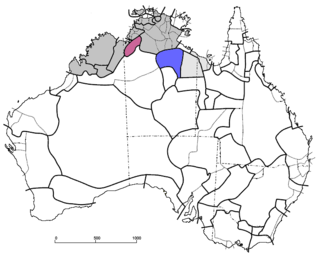
The Mirndi or Mindi languages are an Australian language family spoken in the Northern Territory of Australia. The family consists of two sub-groups, the Yirram languages and the Barkly languages some 200 km farther to the southeast, separated by the Ngumpin languages. The primary difference between the two sub-groups is that while the Yirram languages are all prefixing like other non-Pama–Nyungan languages, the Barkly languages are all suffixing like most Pama–Nyungan languages.
Ngardi, also spelt Ngarti or Ngardilj, is an Australian Aboriginal language that is considered moribund. It was previously thought to be an alternative name for the Bunara language, but these are now classified as separate languages. It was/is spoken by the Ngarti people of the Northern Territory and northern Western Australia.
Wambaya is a Non-Pama-Nyungan West Barkly Australian language of the Mirndi language group that is spoken in the Barkly Tableland of the Northern Territory, Australia. Wambaya and the other members of the West Barkly languages are somewhat unusual in that they are suffixing languages, unlike most Non-Pama-Nyungan languages which are prefixing.
The Ngarnji (Ngarndji) or Ngarnka language was traditionally spoken by the Ngarnka people of the Barkly Tablelands in the Northern Territory of Australia. The last fluent speaker of the language died between 1997 and 1998. Ngarnka belongs to the Mirndi language family, in the Ngurlun branch. It is closely related to its eastern neighbours Binbinka, Gudanji and Wambaya. It is more distantly related to its western neighbour Jingulu, and three languages of the Victoria River District, Jaminjung, Ngaliwurru and Nungali. There is very little documentation and description of Ngarnka, however there have been several graduate and undergraduate dissertations written on various aspects of Ngarnka morphology, and a sketch grammar and lexicon of Ngarnka is currently in preparation.
Wagaya (Wakaya) is an extinct Australian Aboriginal language of Queensland. Yindjilandji (Indjilandji) may have been a separate language. The linguist Gavan Breen recorded two dialects of the language, an Eastern and a Western variety, incorporating their description in his 1974 grammar.
The Binbinga, also pronounced Binbinka, are an Indigenous Australian people of the Northern Territory of Australia.
Rachel Nordlinger is an Australian linguist and a professor at The University of Melbourne. After completing a master's degree at The University of Melbourne, she received her PhD in linguistics in 1997 from Stanford University.
The Garrwa people, also spelt Karawa and Garawa, are an Aboriginal Australian people living in the Northern Territory, whose traditional lands extended from east of the McArthur River at Borroloola to Doomadgee and the Nicholson River in Queensland.
The Yanyuwa people are an Aboriginal Australian people of the Northern Territory. who live in the coastal region inclusive of and opposite to the Sir Edward Pellew Group of Islands in the southern Gulf of Carpentaria.
The Yardliyawara otherwise known as the Jadliaura were an indigenous Australian people of South Australia.
The Emmiyangal, also known as the Amijangal, are an indigenous Australian people of the Northern Territory in Australia,
The Bilinarra, also spelt Bilingara and Bilinara, are an Aboriginal Australian people of the Northern Territory.
The Doolboong, also known as Duulngari, were an indigenous Australian people of the Northern Territory and northeast Western Australia.
The Djaru people are an indigenous Australian people of the southern Kimberley region of Western Australia.
The Marra are an indigenous Australian people of the Northern Territory.
The Gudanji, otherwise known as the Kotandji or Ngandji, are an indigenous Australian people of the Northern Territory.
The Wambaya are an indigenous Australian people of the Northern Territory.
The Jingili or Jingulu are an indigenous Australian people of the Northern Territory.
The Warlmanpa are an indigenous Australian people of the Northern Territory.
The Mudburra, also spelt Mudbara and other variants, are an Aboriginal Australian people of the Northern Territory.